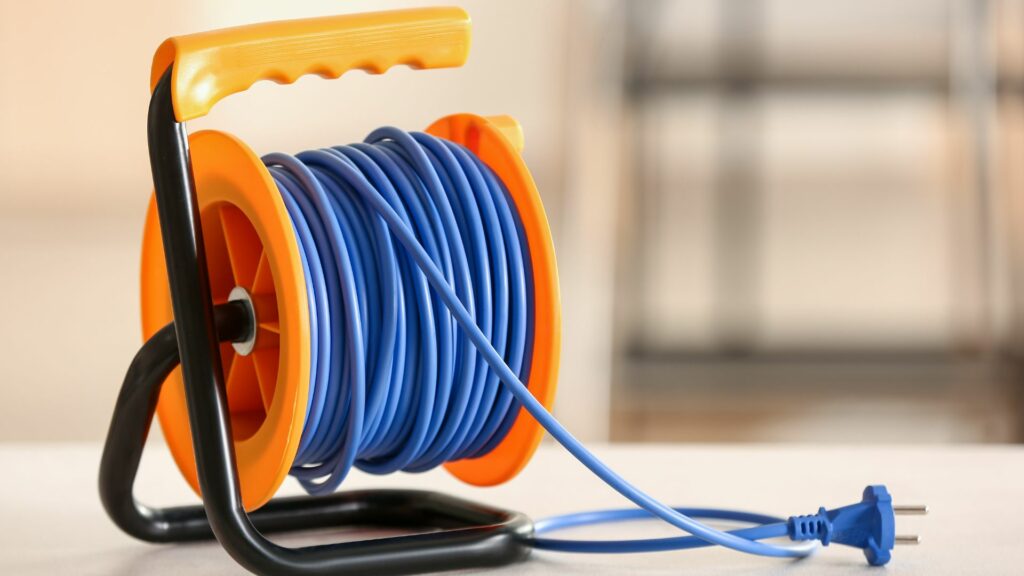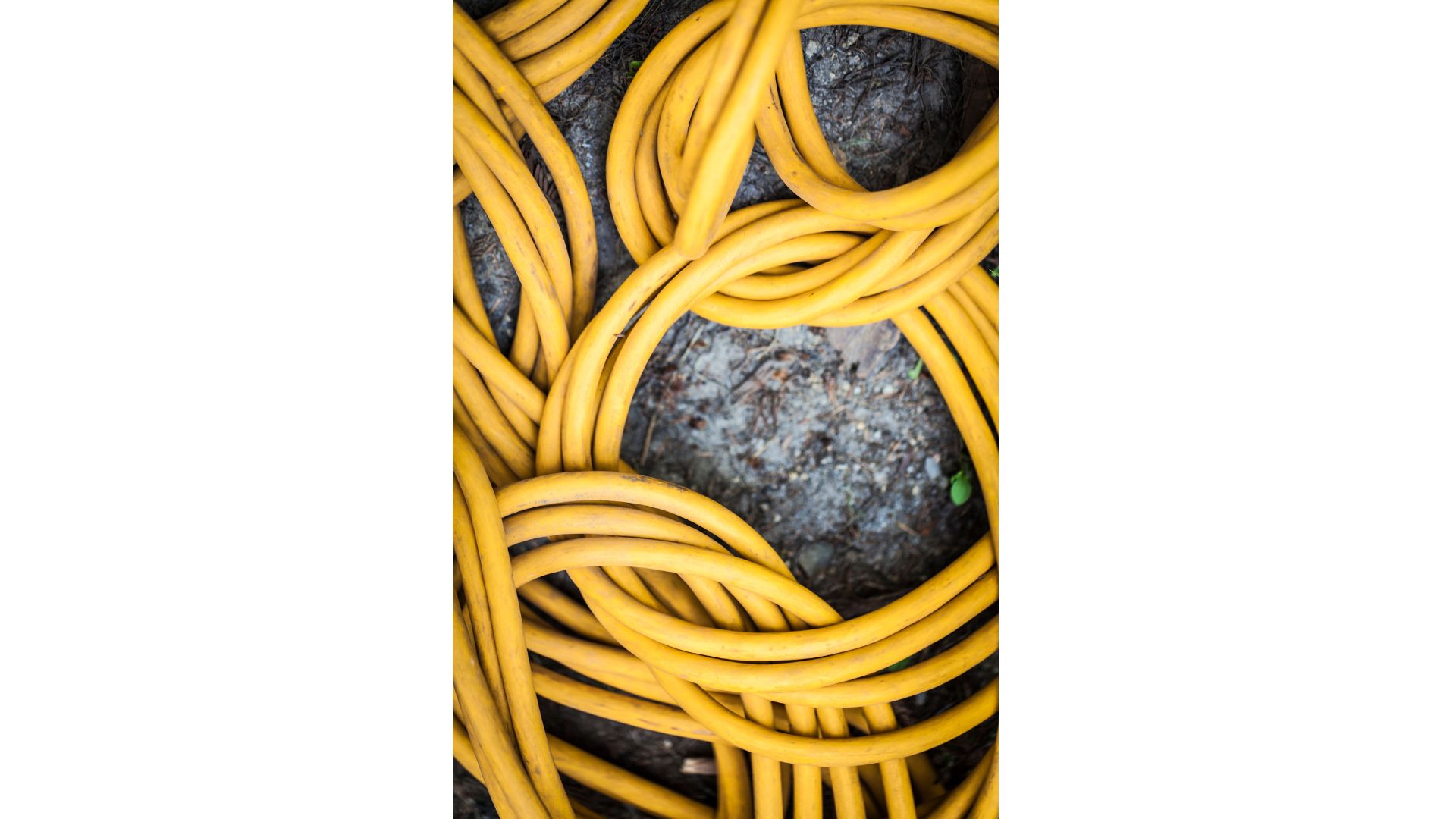Extension cords are generally dangerous, and electricians are rarely surprised when they start fires.
After all, people overload them all the time. It doesn’t occur to consumers to blame extension cord fires on twists, which is a mistake. You can’t fix a problem unless you know what caused it.
The correct term is ‘Cable Corkscrewing.’ Experts blame twisted cables on three primary culprits:
1). Flexing Applications
Extensions deform when you pair them with applications that generate constant flexing and repetitive movements. Sometimes, the conductors inside move independently of the jacket, shifting from their original position and producing that twisted look in the image Wired-And-Cable-Tips has published.
2). Cheap Cable Type
Some cables will twist and corkscrew when you expose them to constant flexing, but others won’t. Why is that? You can blame on the cable type. Layered cables are cheap because they are easier to make.
The manufacturer will place conductors around the core in a circular fashion. Unfortunately, they shift and compress easily. Bundled cables are stronger and more stable.
3). Storage Methodology
How do you store your extension cords? Do you wrap the cable around your arm like most people? While this method is easy, it also twists the cable. The damage gets worse every time you coil the cord this way.
Why Are Twisted Extension Cords Dangerous?
People worry about coiled cables because they can overheat and start fires. The experts at Environmental Health And Safety have pictures of a coiled extension that caught fire. However, twisted extensions are just as deadly:
- The immediate threat is the elevated resistance. It saddles your applications with voltage drops that may compromise their operations.
- Depending on the severity of the twists, the conductors inside the cables may break. Broken conductors cause arcing, which is a fire and electrocution hazard. You may see those broken conductors sticking out of the jacket.
How Do You Prevent Twisted Extension Cords?
The easiest option is to store your extension cord correctly. Many people wrap these cables around their arms, but that will only make the twists worse. Use this method:
- Rather than coiling the cord tightly around your arm, make big loops.
- Plug the ends together.
- Pick an outside loop and pull it away from the rest.
- Wrap the outside loop around the other loops.
- Pull the separated loop through the opening and tug at it gently.
This method is only relevant if you don’t have an extension cord reel. Otherwise, reels are the most convenient option.

You should also select high-quality extension cords. Cables with a strong and tensile core are less likely to twist and bend when you expose them to constant flexing and motion. Check each extension’s specs before you buy it. Look for products with a reinforced jacket.
Usually, experts will encourage you to avoid strenuous installation processes that secure the cable too tightly or bend it out of shape. But that only applies to conventional electrical wiring. Extension cords are temporary solutions. Local inspectors will fine you if you attempt to install an extension cord as you would permanent wiring.
How To Fix A Twisted Extension Cord?
Twisted extensions are inconvenient. But that doesn’t make them a lost cause. You can fix them with one or more of the following solutions:
1). Drill And Masking Tape
- Get your tools: a drill, eyebolt, and tape. You can use other types of tape.
- Loop the cord through the eyebolt using one of the two methods Instructables have illustrated.
- Plug the eyebolt with the cord into the drill.
- Run the other end of the extension to a tree. Any stable object, such as a lamp post, will do.
- Study the cable. What direction is the twist? You need to answer this question because the drill should spin in the opposite direction. Otherwise, you will make the twist worse.
- Use the drill to unwind the cable. Don’t stop at simply removing the twists. Add a little twist to the extension in the opposite direction to make it as straight as possible.
2). Sunlight and Trees
- Find two stable objects a significant distance apart. Many people use trees and posts.
- Tie the twisted extension in between the trees.
- Stretch the cord. It should be tense.
- Leave it alone.
- Every few days, you should come back and pull the cable a little tighter. But don’t make it so tight that you damage the conductors.
- The sunlight is vital to this process because it makes the cord pliable, allowing you to stretch it. In other words, you can’t use this method during the winter months. Wait for the summer sun.
- Eventually, this method will remove the twists and kinks. However, don’t expect the extension to look the way it did when you first bought it.
- Unravel any knots in the extension before attempting to stretch the cable.
3). Manual Approach
The manual approach is exactly what it sounds like. Rather than using a drill or the sun, you use your hands:
- Take the cable in your hands and extend your arms fully.
- Maintain a tight grip while pivoting your hands. Do this with both hands.
- Some people still use the sun here. They place the cable outside, allowing the sun’s heat to make it more pliable before performing the motions mentioned above.
You don’t have to follow the procedure above strictly. Any method that turns the cable in a direction opposite to the twists will do.
4). Jump Rope
This method mimics the sunlight and tree method. However, it has one significant difference:
- Tie one end of the cord to a stable object, such as a tree.
- Take the other end and pull the cord until it is straight.
- Rather than tying the second end to another tree, hold the cord firmly and whip it around like a jump rope. Move the cord in the opposite direction of the twists.
- Whip the cord ten times, stop, and pull on it to stretch it.
- Whip the cord around another ten times before pulling it.
- Repeat the steps above until you remove all the twists.
If you’ve never fixed a twisted, kinked, or damaged extension, you should keep the following in mind:
- The size and quality matter. Thin, fragile, low-quality cables will break if you stretch them.
- Some extensions are damaged beyond repair. You can tell by looking at them. They are badly wrinkled, and they tend to overheat. Don’t hesitate to replace them.
- If the twists and kinks have exposed some of the wires, cover them with electrical tape. Apply several layers of tape and pull it to form a tight seal. However, this only works with superficial damage. If you can see the conductors beneath the insulation, get a new extension.
- Don’t forget the plug. Sometimes, coiling the cable around your elbow and storing it poorly can weaken the connection between the wires and the plug. Loose connections are dangerous because they cause arcing. You can either tighten those connections or replace damaged plugs.

